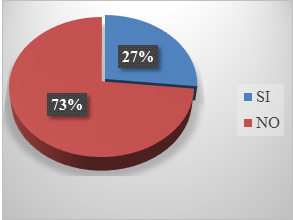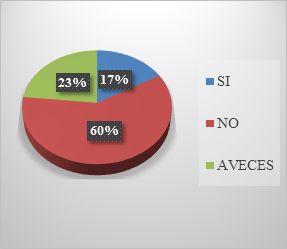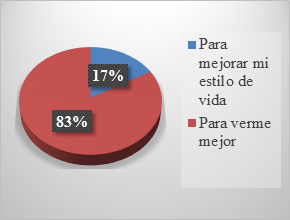Mi SciELO
Servicios Personalizados
Articulo
Indicadores
-
 Citado por SciELO
Citado por SciELO
Links relacionados
-
 Similares en
SciELO
Similares en
SciELO
Compartir
Revista de Ciencias Médicas de Pinar del Río
versión On-line ISSN 1561-3194
Rev Ciencias Médicas vol.27 supl.1 Pinar del Río 2023 Epub 01-Jul-2023
Articles
Assessment of orofacial harmonization in young women
1Los Andes Autonomous Regional University, Santo Domingo, Ecuador.
ABSTRACT Introduction: orofacial harmonization achieves with a series of non-invasive or minimally invasive, therapeutic and aesthetic procedures, regenerate, reposition or restore volume and harmony to the tissues that link the smile with the other components of the facial region. Objective: to evaluate the knowledge of young women about orofacial harmonization, its use and effectiveness in the city of Salcedo, Ecuador. Methods: an observational, descriptive, cross-sectional, descriptive study was designed to evaluate the knowledge of young women between 20 and 30 years of age about orofacial harmonization, its use and effectiveness, September-December 2022, city of Salcedo, Ecuador. The universe was constituted by 43 women, by means of simple random probability sampling and according to the inclusion and exclusion criteria, a sample of 30 women was obtained. The study data, tabulated and processed using Microsoft Excel, were obtained through a survey prepared for this purpose. Results: it was determined that a large part of the sample is unaware of this treatment, 27 % of the women know what orofacial harmonization is, while 73 % do not. 60 % of the women surveyed feel that they are not familiar with this treatment. Sixty percent of the women surveyed feel satisfied with their face while 23 % do not. While 17 % of the women choose this treatment only for aesthetic purposes while 83 % for their lifestyle. Conclusions: the passage of time, loss of teeth, aging, sun damage, harmful habits or genetics make patients seek a solution with these treatments to improve their physical and emotional health and to accompany aging more effectively.
Key words: OROFACIAL; DEGENERATION; BOTULINUM TOXINS; TYPE A; ESTHETICS; ESTHETICS, DENTAL.
INTRODUCTION
Orofacial harmonization, according to Carbone A,1 seeks harmony and naturalness of the elements that make up the smile in an integral way combining aesthetics and function to restore signs of youth that were lost during the aging process. That is, based on minimally invasive techniques, the smile can become harmonious, balanced and proportional, which is framed in a whole that is the face.
In this technique, value is given to all facial tissues to achieve comprehensive results as a new way of acquiring the facial beauty dreamed of by many patients. Where appropriate, specialists must have rigorous management in this area from diagnosis to clinical application of treatments based on extensive knowledge of the facial area, not only anatomically but also analytically.1
Based on this concept, the conception of the cornerstone of this article is proposed, supported by the orofacial or stomatognathic system, which represents, according to some authors,2 “skeletal muscles, [...] the salivary glands, nasal and paranasal mucosa , ocular (lacrimal) and other minor ones associated with the complex organs that make up the system such as the mouth, nose, pharynx, larynx, ear, and reaching the ocular structures, although partially”. In other words, it includes the muscles, lips, tissues, masticatory system, TMJ, among others, and the teeth whose functions are phonation, mastication, swallowing, and aesthetics.
By integrating this orofacial system with intelligent beauty, the concept of intelligent orofacial beauty is postulated as the harmonious and symmetrical balance that is provided to the complex organs that are members of the orofacial system, such as the nervous, anatomical, and physiological unit that is located in the skull territory. -cervico-facial made up of its different structures, which will allow large doses of perfection to be achieved based on the stimulation of cellular rhythm through products and smart technologies, both minimally invasive and multifunctional, in order to combat the causes of aging under a philosophy based on prevent, correct and preserve.2
It is relevant that the dental professional has vision and knowledge not only of facial anatomy, but also of the needs and expectations of each of the clients, without neglecting multidisciplinary treatment if necessary.3 By knowing what what the customer is looking for and provide them with the different options of the latest trends in research, development and scientific innovation, it is possible to provide them with an intelligent facial balance, that is, that perfection can be achieved through intelligent beauty conceptualized by Navarro C,(4 ) as the harmonious set of interior and exterior interpreted as a whole that, together with innovations such as biotechnology and nanotechnology, offer evolution because now the cosmetics sector is committed to intelligent products.
From the indicated elements we were able to establish the need to evaluate the knowledge of young women about orofacial harmonization, its use and effectiveness, Salcedo city, Ecuador.
METHODS
An observational, descriptive, cross-sectional, descriptive study was designed to evaluate the knowledge of young women between 20 and 30 years of age about orofacial harmonization, its use and effectiveness, period September-December 2022, city of Salcedo, Ecuador. The universe was constituted by 43 women, by means of simple random probability sampling and according to the inclusion and exclusion criteria, a sample of 30 women was obtained. The study data, tabulated and processed using Microsoft Excel, were obtained through a survey prepared for this purpose. Descriptive statistics and percentage data were used to show the results.
Inclusion criteria
Women undergoing dental or facial treatment as part of orofacial harmonization treatment.
Women who are willing to collaborate with the research.
Exclusion criteria
Women who have not started treatment or have completed treatment.
Women who do not agree to answer the survey.
The variables used were: knowledge about orofacial harmonization, physical recognition of emotions, concerns with Botox, reason for choosing the treatment, knowledge about the indications and contraindications of Botox.
The study data, tabulated and processed using Microsoft Excel, were obtained by means of a survey elaborated for such purposes. The principles of medical ethics were complied with and the research was carried out after approval by a scientific and expert committee.
RESULTS
It was possible to determine that there is a lack of knowledge on the part of a large part of the sample about this integral aesthetic treatment and all the benefits it provides beyond the facial region; 27 % of the women know what orofacial harmonization is, while 73 % do not. (Graph. 1)
It was found that 60 % of the women surveyed were satisfied with their face while 23 % were not. (Graph. 2)
Half of the women surveyed know about Botox and the other half do not, an important issue for both the patient and the professional who must explain to the patient both the benefits and the risks (Graph. 3).
It can be seen that 17 % of women choose this treatment only for aesthetic purposes while 83 % for their lifestyle. (Graph. 4).
7 % of the women are allergic to Botox, in this case it is not recommended to have these treatments, while 93 % have no reaction to this treatment (Graph. 5).
DISCUSSION
So, with technological advances, nanotechnology present in materials, new whitening agents, together with the concern for the appearance of the client-patients, dentistry has turned in search of selective procedures that focus on the esthetic improvement of their teeth, giving rise to the era of dentistry based on desires.5
Harmonize is derived from the base word harmony which means the action of balancing, providing and adequately matching the different things in a set. Then, it is highlighted that facial harmonization is defined as a set of aesthetic procedures that, when combined, improve facial symmetry, transform some features and treat skin aging characterized by loss of elasticity, volume and fat prior to a clinical diagnosis.6
It is a new concept that seeks to highlight the natural beauty of each person, enhancing its favorable points and softening the defects, with a personalized evaluation. The focus is not on the treatment of wrinkles and furrows, but on improving every detail of the face, defining the angles of the face, the chin with a small projection, well delineated contours, without exaggerating in the filling of lips and cheekbones, we can achieve excellent results with combined techniques.6
Our study does not coincide with that carried out by Herrera A and Soto N,7 where the greatest interest of the patients was for dental treatments unlike this research where the patients were more interested in their facial aesthetics without recognizing that dental aesthetics is part of facial aesthetics.
Due to the natural aging process, the passage of time makes the skin of the face and neck thinner, loses elasticity and collagen, becoming more flaccid, and expression lines deepen, there is dryness and compromise of the dermoepidermal junction and alterations in the color and texture of the skin in general. In order to compensate this natural aging process there are different techniques that will be recommended according to the degree of compromise suffered, the most frequent are:8
1. Botulinum Toxin: this substance besides its aesthetic purpose of reducing wrinkles and expression lines, also has therapeutic purposes in the treatment of bruxism, headaches, gummy smile avoiding muscle contraction and relaxing the musculature. Its action lasts from four to six months.
2. Peeling: Application of acid substances that promote a slight desquamation of the outermost layer of the skin stimulating cell renewal.
3. Intradermotherapy: Use of collagen inducing biomaterials such as vitamins, amino acids, minerals, growth factors. Among these substances, the ones that have produced the greatest impact worldwide are the Collagen Biostimulators which provoke an inflammatory reaction when injected and the organism responds with an increase of collagen for up to two years.
4. Hyaluronic acid filler: Corrects wrinkles and expression lines, replenishes volume to redefine facial contours, jaw, nose and dark circles under the eyes.
5. Lipoplasty procedures: It can be mechanical which corresponds to aspiration of localized fat, and chemical with Deoxycholic acids.
6. Bichectomy: It is recommended for aesthetic reasons to make the face thinner and elongated and for functional reasons to avoid cheeks bite. It consists in the surgical removal of the Bichat's ball and not the scars.
CONCLUSIONS
Orofacial Harmonization is a set of therapeutic and aesthetic procedures that aim to harmonize aesthetically and functionally the mouth and face, in addition, it is important to mention that this topic has gained much ground in dentistry because it offers minimally invasive and relatively simple procedures that provide incredible results. Nowadays it can be performed through special techniques, it is possible to balance the functional and aesthetic part of an individual's face. Botulinum toxin is one of the main materials used in orofacial aesthetic treatment, since its action consists of neuromodulation, and it is not always strictly aesthetic, but it is also a functional therapy that helps patients with problems that compromise quality of life, such as gummy smiles, bruxism and tension headaches.
BIBLIOGRAPHIC REFERENCES
1. Carbone A. Armonización orofacial. Casos clínicos. Tomo 11. . Amolca [Internet]; 2019 (citado 16/02/2023). Disponible en: Disponible en: http://www.libreriaserviciomedico.com/product/477610/mdm-armonizacion-orofacial-tomo-1---carbone 1. [ Links ]
2. Susanibar F., Douglas, CR., Dacillo C. Fundamentos fisiológicos de la sensibilidad del sistema estomatogná tico, en EOS (ed.), Motricidad orofacial. Fundamentos basados en evidencias.2. [Internet]; 2013 (citado 16/02/2023): 141-176. Disponible en: Disponible en: https://www.researchgate.net/publication/305400434_Fundamentos_fisiologicos_de_la_sensibilidad_del_sistema_estomatognatico 2. [ Links ]
3. Herrera A, Soto Aguirre N. La belleza orofacial inteligente: una reflexión epistémica desde el cliente odontolófogico venezolano. CIENCIA ergo-sum[Internet]. 2022(citado 16/02/2023); 29(2). Disponible en: Disponible en: https://cienciaergosum.uaemex.mx/article/view/15360/13723 3. [ Links ]
4. Navarro C. Belleza inteligente4. [Internet]; 2013 (citado 16/02/2023) Disponible en: Disponible en: https://quelibroleo.com/belleza-inteligente 4. [ Links ]
5. Christensen G. Elective vs. mandatory dentistry. J Am Dent Assoc [Internet]. 2000 (citado 16/02/2023); 131(10): 1496-98. Disponible en: Disponible en: https://pubmed.ncbi.nlm.nih.gov/11042991/ 5. [ Links ]
6. Díaz de Villabona N, Valero N, Rincón F, David C, Velazco Viloria GJ, Solórzano N. Rinomodelación, fundamento morfológico. Acta Bioclínica [Internet]. 2020 (citado 16/02/2023); 10(20): 152-170. Disponible en: Disponible en: https://dialnet.unirioja.es/servlet/articulo?codigo=8929505 6. [ Links ]
7. Herrera A., Aguirre Soto N. La odontología desde la perspectiva de la belleza: armonización orofacial. Revista de la Facultad de Odontología [Internet]. 2022 (citado 16/02/2023); 15(1): 1668-7280. Disponible en: Disponible en: http://dx.doi.org/10.30972/rfo.1515938 7. [ Links ]
8. Machado Filho DA, Germani Vieira M, Tanajura E, Cruz Corrêa B, Marguardt Filho EJ. Planejamento digital em harmonização orofacial-facial design. Simmetria Orofacial Harmonization in Science [Internet]. 2020 (citado 16/02/2023); 1(4):95-104. Disponible en: Disponible en: https://www.redalyc.org/journal/4215/421573359001/html/ 8. [ Links ]
Received: December 20, 2022; Accepted: March 08, 2023











 texto en
texto en 







